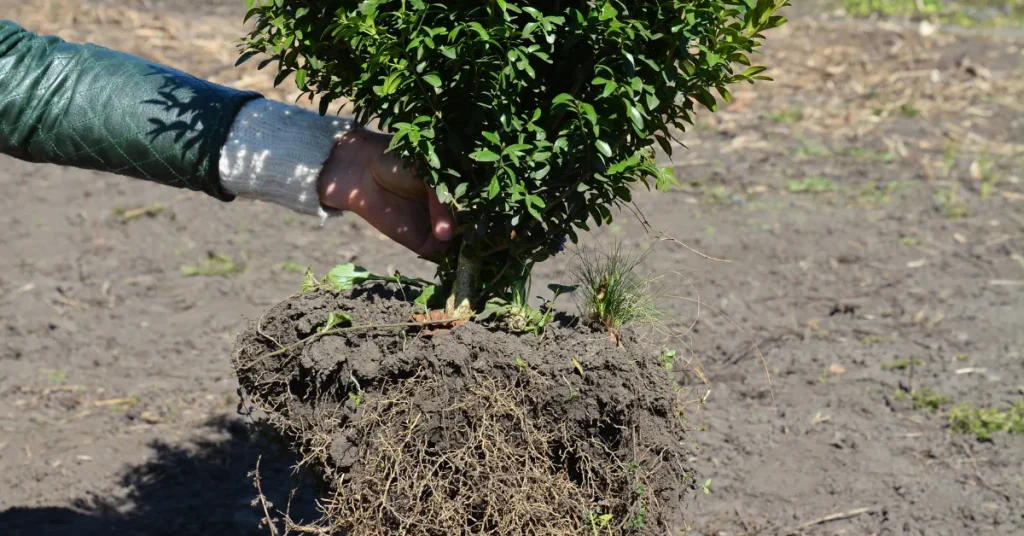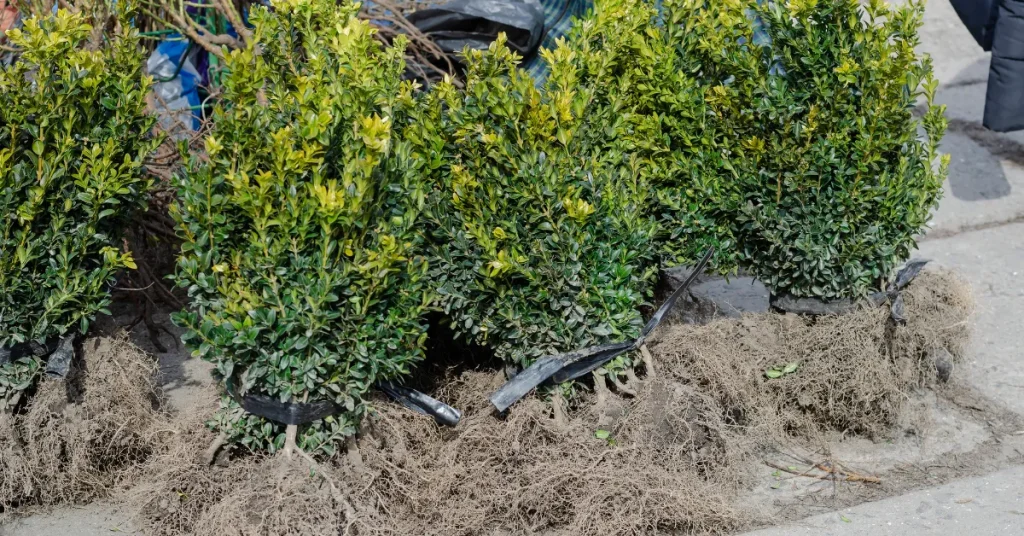Boxwood roots typically extend down about 1 to 2 feet. The spread of the root system is usually not beyond the perimeter of the shrub’s branches.
Understanding the root depth of boxwoods is essential for gardeners to ensure proper planting and maintenance.
These shrubs are popular for their dense, evergreen foliage and versatility in landscape design. They serve as excellent hedges, borders, and decorative topiaries.
Gardeners favor boxwoods because they are hardy and adaptable, but knowing the specifics of their root system helps in preventing damage to nearby structures and promoting healthy growth.
Properly planted and cared for, boxwoods can thrive and maintain their lush appearance, enhancing the aesthetic of any garden or landscape project.

The Secret Life Underground: Boxwood Root Characteristics
Think of boxwoods, and you picture neat hedges and green borders. But what about the world beneath? Boxwood roots play a huge role in its growth and health. This guide sheds light on the mysterious life of boxwood roots.
Root Depth And Spread
Contrary to what some might think, boxwood roots are not too deep. They have a shallow root system. The depth is usually as wide as the plant’s spread above ground.
- Shallow Roots: Typically found within the top 12 inches of soil.
- Root Width: Can extend up to twice the width of the plant’s crown.
Types Of Roots: Taproot Vs. Fibrous
Boxwoods have two distinct root types. The primary root is the taproot. Then, you have the fibrous secondary roots.
| Root Type | Features | Benefits |
| Taproot | Deep central root | Stabilizes the plant |
| Fibrous Roots | Spread out from the taproot | Absorbs nutrients and water |
Most boxwoods develop a strong taproot only as young plants. Then, the focus shifts to growing fibrous roots. The fibrous roots are important for gathering all the goodness from the soil.
Factors Influencing Boxwood Root Development

Understanding the root depths of boxwoods is crucial for gardeners. Factors such as soil, water, and plant age affect root growth. This ensures a boxwood’s health and stability. Let’s dive into what influences the root system of these versatile shrubs.
Soil Type And Nutrient Availability
Soil plays a vital role in root development. Different textures and nutrient contents can alter root growth patterns. Sandy soils encourage deeper rooting due to ease of penetration. Clay soils may limit depth and spread of roots.
Nutrients within the soil contribute to root health. Poor soils need proper fertilization for optimal growth. Adequate nutrients in the right balance support stronger and more extensive root systems.
Water And Drainage Impact
Water availability and drainage affect boxwood roots. Adequate hydration encourages root expansion. Roots extend to find moisture in dry conditions.
Excessive water and poor drainage can lead to shallow root systems. Roots may suffer from rot in waterlogged soils. Good drainage is crucial for deep, healthy roots.
Age And Maturity Of The Plant
Roots grow as the plant ages. Young boxwoods have shallower roots. As they mature, their roots delve deeper.
Mature boxwoods boast a more established root system. This anchors the plant firmly and supports its top growth. Keep in mind that older plants need careful maintenance to maintain root health.
Measuring Boxwood Root Health And Vigor
Healthy roots are key to a thriving boxwood garden. Understanding the depth and vigor of your boxwood’s roots is essential.
Checking root health helps ensure that your plants remain strong and resilient. This section will guide you through assessing the robustness of your boxwood’s root system.
Signs Of Healthy Roots
A robust root system is a foundation for a healthy boxwood. Look for these positive indicators:
- Color: Healthy roots often appear white or light tan.
- Texture: They should feel firm and flexible, not mushy.
- Smell: Good roots usually have an earthy scent.
- Growth: New growth suggests vitality.
Common Root Problems And Diseases
Be alert to signs that your boxwood may be in trouble. Here are issues to monitor:
| Problem | Signs | Impact |
| Root Rot | Browning, soft roots. Plant wilting. | Can kill the plant. |
| Nematodes | Knots on roots. Stunted growth. | Impairs nutrient uptake. |
| Fungal Diseases | Discolored roots. Visible mold. | Weakens root system. |
Best Practices For Encouraging Strong Boxwood Root Growth
Healthy boxwood plants start with robust root systems. Understanding the depth of boxwood roots is critical to provide the right care.
Typically, boxwood roots spread wide rather than deep. To cultivate vigorous roots, gardeners must adopt best practices in planting, watering, fertilization, and soil management.
Proper Planting Techniques
Planting boxwoods correctly sets the stage for strong root growth. Dig a planting hole three times as wide as the root ball but only as deep. This allows roots to expand easily. Ensure the top of the root ball is level with the soil surface. Overly deep planting can suffocate roots.
Optimizing Watering And Fertilization
- Water deeply and infrequently to encourage roots to seek moisture.
- Use soil moisture meters to prevent over-watering.
- Apply a balanced fertilizer in spring to provide essential nutrients.
Mulching And Soil Management
Mulching conserves soil moisture and regulates temperature. A 2-3 inch layer of organic mulch keeps roots healthy.
Avoid piling mulch against the stem to prevent rot. Soil pH should be between 6.5 and 7.2 for optimal root growth. Regularly test and amend soil as needed.
Proper care ensures deep, strong boxwood roots. These roots can survive drought and harsh conditions. By following these practices, a gardener can ensure a flourishing boxwood display for years to come.
Interactions With The Environment: Boxwood Roots And Ecosystems

Interactions with the Environment: Boxwood Roots and Ecosystems play a crucial role in maintaining the health and stability of natural spaces.
Boxwood roots, often unseen, weave a story beneath the soil, influencing everything from soil composition to local plant life. The depth and structure of these roots can benefit the ecosystem in various ways. Let’s explore these interactions.
Roots As Erosion Control
The network of boxwood roots stabilizes soil and helps prevent erosion. Strong root systems hold the ground in place, protecting it against the forces of wind and water.
This natural barrier is essential for the environment, especially in areas prone to heavy rains or high winds.
Coexistence With Other Plant Species
Boxwoods harmonize with surrounding flora, sharing resources without overwhelming them. Their roots grow to a moderate depth, allowing other plants to thrive alongside. This coexistence supports biodiversity, making ecosystems robust and resilient.
FAQs About How Deep Are Boxwood Roots
How Deep Do Boxwood Roots Typically Grow?
Boxwood roots generally extend down about one to two feet. They spread outwards, often reaching beyond the plant’s canopy. This shallow root system allows for easier maintenance and transplanting.
Can Boxwood Roots Damage Foundations Or Pipes?
Boxwood roots are not typically aggressive or strong enough to cause damage to foundations or underground pipes. They are less likely to pose such risks compared to deeper-rooted trees and shrubs.
What Factors Influence The Depth Of Boxwood Roots?
Soil quality, water availability, and the boxwood variety can influence root depth. Well-drained, loamy soils encourage deeper root growth, whereas compacted soils may limit root extension.
Is Root Depth Important For Boxwood Health?
Yes, adequate root depth is crucial for boxwood health. It ensures stability and access to nutrients and water. However, boxwoods are tolerant of varying root depths thanks to their adaptability.
Conclusion
Understanding boxwood root depth helps gardeners make informed decisions. Boxwoods typically have shallow roots, usually expanding two feet deep or less. Effective watering and soil management can enhance root health and overall plant stability.
Remember, the root system’s extent can greatly influence your boxwood’s success, ensuring a verdant and robust garden.
Resources:
1. https://ag.umass.edu/landscape/fact-sheets/boxwood-common-health-issues-in-landscape
